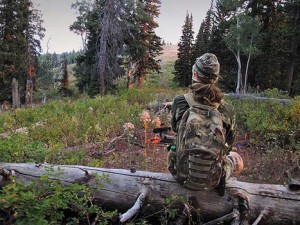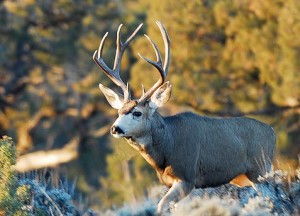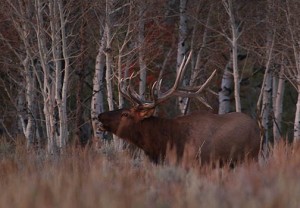The next two articles address the future of hunting and the changes I predict will happen to both hunters and their prey through the natural process of adaptation and evolution.
The Future of Hunting (Part 1)
Rest assured hunting will change in the future, just as it has been changing rapidly over the last 30 years or so. The three primary factors driving these changes: a) an exploding human population, b) the development of super high-tech hunting equipment, and c) the hyper-adaptation of prey-animals which is necessary for their survival, especially concerning elk and deer.
What’s been occurring, and will continue to occur is a split–or chasm–between hunters and super-hunters. Hunters will either do what it takes to get a buck, or they will fail most of the time. Most hunters can be divided into two camps depending on their priorities. These two camps are: a) Super-hunters dedicated to the sport and willing to spend tremendous resources for trophy-class animals, and b) Fair-weather hunters who spend little time afield, hunt mostly for fun rather than food, hunt mostly on weekends, and are happy with any deer, whether a spike or a 4-point.
A similar split is occurring between regular deer and super-deer. This means there will be isolated groups of less experienced and less pressured animals that react much like their ancestors did and get shot. The rest will adapt quickly to modern hunters, developing much more specialized bodies and evading the average hunter for life.
Here are some of the changes I predict will occur, or are already occurring, in today’s deer and elk:
Future Changes in Deer
- Deer will become completely nocturnal. The reason you see more deer at evening and morning is because they’re most active at night. But if left undisturbed, deer will occasionally rise and feed during the day. In the future, not so much. Deer’s eyes are already adapted to see well at night, but in the future I predict that their eyesight will become further specialized to low-light conditions. The trade-off is that their eyes will become highly light-sensitive, causing them to bed even farther into super-deep/dark timber and never emerge until it’s completely dark. I’ve already witnessed deer doing this in high-hunter pressure areas. So much for seeing deer early and late.
- Deer will grow narrower racks. This is already the case in places like Oregon and Washington where bucks live in dense timber full time. Since the popularization of the long-range rifle, I’ve noticed that deer in the Intermountain West the previously fed in the open are now spending more time in the thick timber. And since a wider rack impedes their movement, their antlers are already becoming narrower.
- Deer will grow longer legs, similar to elk. Deer naturally have a difficult time moving through deep snow; basically anything over 30 inches. Thus, they are forced to winter on lower elevations. The problem is that humans are developing on most winter range elevations, especially here in Utah. This makes them highly susceptible to death via highways, dogs, poachers, destruction of native forage, and other wintertime stresses that force them to burn through fat reserves. As this is a fairly recent phenomenon, deer haven’t had time to develop bigger bodies and longer limbs which would allow them to winter at much higher elevations; but they will, eventually!
- Deer will grow bigger hooves. Until recently, deer haven’t had to live in very cliffy or rocky terrain. But they are starting to. With increased pressure, dwindling habitat and the threat of long-range rifles, deer are increasingly forced into some very unnaturally rugged terrain. My brother-in-law Josh actually found bucks living in and around caves in the unit where he hunts. Have you ever noticed how small a deer’s hooves are compared to cliff-dwelling species such as sheep or goats? As a taxidermist I’ve had the opportunity to compare various characteristics between species. Sheep and goats have approximately the same body mass as deer, but their hooves are nearly twice as big. Other than size, another interesting difference between deer and goat hooves is the foot pad. The footpad of any hooved animal is made of a softer, cartilage-like material. But the goat’s hoof is much softer than the deer’s which allows goats to grip onto rocks easier. I predict that deer will develop not only bigger hooves, but softer ones too.
- Deer will grow bigger brains. Any trophy hunter already knows how incredibly smart today’s bucks are, but they will become smarter yet! This is a simple law of nature: survival of the fittest. As humans develop smarter hunting technology, the deer will be forced to adapt. In a previous article I wrote about the different and ingenious ways that deer have adapted to hunters in just my lifetime. Big bucks are using higher levels of intelligence to evade hunters. Some examples include using does as security buffers between open feed and tree line, moving into non-deer habitat such as caves, and using complex sentinel-based security systems.
Future Changes in Elk
Now let’s look at future changes in elk:
- Elk will become mostly silent, like deer! After just a few decades of calling to them, big bulls are becoming increasingly less vocal. This is the basis of the relatively recent “silent calling” technique, wherein modern bulls often approach a caller without calling back. Thirty years ago it was easy to bugle up a bull. Now that bulls have wizened up to bugling techniques, we’ve switched over to primarily cow calling. But even this technique is becoming increasingly ineffective. Smart bulls now distrust any calling and rely instead on wind and scent before coming to a call. Simultaneously archery equipment has become far more efficient, forcing bulls to hang up farther and farther back. Now I predict a time when elk are completely silent and use scent and wind direction to rut around, just like deer already do.
- Elk will grow narrower and smaller racks. Just like deer, elk will move deeper and deeper into thick timber and will therefore be forced to grow narrower racks for easier travel through dense timber.
- Elk will grow bigger ears. Relative to their body, elk ears are fairly small, albeit efficient. But just like their mule deer cousins, there’ always room for bigger ears. Since elk will become more timber-dwelling, and since sound doesn’t travel nearly as far in thick forests, elk will need bigger ears to locate both danger and other elk.
- Elk will develop better vision. Elk and deer eyes are practically the same: good night vision, wide field of vision, and sensitive to movement. But deer species’ eyes have two major weaknesses: a) they can’t see the color red, and b) they can’t see fine detail. This is why an elk can’t see you standing five feet away, unless you move. Of course they use their noses to make up for this shortcoming, but their eyesight has room for improvement. In the future I predict elk and deer will either develop the ability to see a broader color spectrum, and/or their eyes will evolve to see better detail.
- Elk will have smaller bodies. During the last ice age, animals had much bigger bodies which allowed them to survive better in low temps, move through deep snow, and evade larger predators like the saber-toothed tigers. After the ice age, animals got smaller. Today’s elk are much larger than most other western big game animals. This is advantageous during winter, but for the rest of the year it hinders them in two ways: a) they need to water more frequently, and b) they need to eat more food more often. As any predator knows, it’s much easier to ambush an animal that’s feeding and watering. Unlike deer, this makes hunting elk over water a viable option. Also, because elk are grazers rather than foragers, it’s easier to predict food sources and travel routes. In the future, smaller elk won’t need to water as often and will likely adapt their stomachs to include browse-type foods such as forbs/shrubs/etc. As a result, they will bed earlier, rise later and probably become completely nocturnal as well.
- Elk will grow smarter. I suppose they’re already kinda smart, but they’re getting smarter yet. Last year, while hunting with my wife, we called up a herd bull by using an estrus call. The bull came stomping in, and then, just before showing himself, pushed two cows right through us. When the cows passed the shooter they picked up her scent and bolted taking the bull with them. This well-thought-out security measure worked perfectly. In the future I predict elk will develop even more sophisticated security techniques to avoid hunters.
Conclusion
For all of evolution, both predator and prey were forced to adapt to each other to survive. In today’s world, finding and harvesting a trophy animal is getting increasingly more difficult each year. Today’s deer are ingenious survivors capable of adapting to us and evading us no matter what we throw at them. It just proves that technology isn’t the answer.
On the flip side, we should be thankful that our beloved deer are such brilliant survivors. Otherwise there wouldn’t be anything left to hunt.
Stay tuned for the next article where we analyze the future of hunting and the division between hunting camps. I think you’re gonna like it.




Good topic to address. It really highlights the importance of staying ahead of the game to be successful. But may also point toward the demise of the weekend warrior (‘fair weather hunter’), for better or worse.
I think you are right about the evolutionary possibilities for deer and elk. I think the physical changes will be slow to take place. But the behavioral changes are already happening, and for some animals in some of heavily hunted locations they may have already completed all of your proposed behavior changes, and then some.
However, there are a lot of factors or pressures that can affect the ultimate outcome and evolution of these species. Management practices, future popularity of hunting or lack thereof (see whitetail in eastern U.S., for example), cost, management of predators (i.e., wolves), available public lands, advances in technology and rules/regulations that allow or prohibit their applications, politics, agenda 21, etc.
Looking forward to part 2.